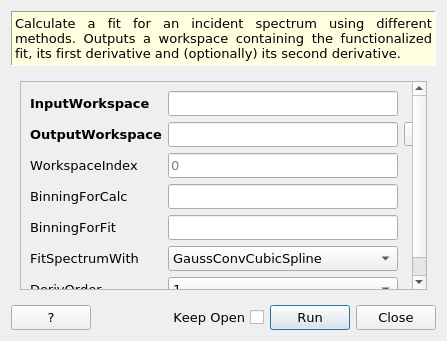\(\renewcommand\AA{\unicode{x212B}}\)
FitIncidentSpectrum v1¶

FitIncidentSpectrum dialog.¶
Summary¶
Calculate a fit for an incident spectrum using different methods. Outputs a workspace containing the functionalized fit, its first derivative and (optionally) its second derivative.
Properties¶
Name |
Direction |
Type |
Default |
Description |
|---|---|---|---|---|
InputWorkspace |
Input |
Mandatory |
Incident spectrum to be fit. |
|
OutputWorkspace |
Output |
Mandatory |
Output workspace containing the fit and it’s first derivative. |
|
WorkspaceIndex |
Input |
number |
0 |
Workspace index of the spectra to be fitted (Defaults to the first index.) |
BinningForCalc |
Input |
dbl list |
Bin range for calculation given as an array of floats in the same format as Rebin: [Start],[Increment],[End]. If empty use default binning. The calculated spectrum will use this binning |
|
BinningForFit |
Input |
dbl list |
Bin range for fitting given as an array of floats in the same format as Rebin: [Start],[Increment],[End]. If empty use BinningForCalc. The incident spectrum will be rebined to this range before being fit. |
|
FitSpectrumWith |
Input |
string |
GaussConvCubicSpline |
The method for fitting the incident spectrum. Allowed values: [‘GaussConvCubicSpline’, ‘CubicSpline’, ‘CubicSplineViaMantid’] |
DerivOrder |
Input |
number |
1 |
Whether to return the first or first and second derivative of the fit function. Allowed values: [‘1’, ‘2’] |
Description¶
This algorithm fits and functionalizes an incident spectrum and finds its first derivative and optionally its second derivative. FitIncidentSpectrum is able to fit an incident spectrum using:
GaussConvCubicSpline: A fit with Cubic Spline using a Gaussian Convolution to get weights.
CubicSpline: A fit using a cubic spline.
CubicSplineViaMantid: A fit with cubic spline using the mantid SplineSmoothing algorithm.
Usage¶
Example: fit an incident spectrum using GaussConvCubicSpline [1]
import numpy as np
import matplotlib.pyplot as plt
from mantid.simpleapi import \
AnalysisDataService, \
CalculateEfficiencyCorrection, \
ConvertToPointData, \
CreateWorkspace, \
Divide, \
FitIncidentSpectrum, \
Rebin
# Create the workspace to hold the already corrected incident spectrum
incident_wksp_name = 'incident_spectrum_wksp'
binning_incident = "%s,%s,%s" % (0.2, 0.01, 4.0)
binning_for_calc = "%s,%s,%s" % (0.2, 0.2, 4.0)
binning_for_fit = "%s,%s,%s" % (0.2, 0.01, 4.0)
incident_wksp = CreateWorkspace(
OutputWorkspace=incident_wksp_name,
NSpec=1,
DataX=[0],
DataY=[0],
UnitX='Wavelength',
VerticalAxisUnit='Text',
VerticalAxisValues='IncidentSpectrum')
incident_wksp = Rebin(InputWorkspace=incident_wksp, Params=binning_incident)
incident_wksp = ConvertToPointData(InputWorkspace=incident_wksp)
# Spectrum function given in Milder et al. Eq (5)
def incidentSpectrum(wavelengths, phiMax, phiEpi, alpha, lambda1, lambda2,
lamdaT):
deltaTerm = 1. / (1. + np.exp((wavelengths - lambda1) / lambda2))
term1 = phiMax * (
lambdaT**4. / wavelengths**5.) * np.exp(-(lambdaT / wavelengths)**2.)
term2 = phiEpi * deltaTerm / (wavelengths**(1 + 2 * alpha))
return term1 + term2
# Variables for polyethlyene moderator at 300K
phiMax = 6324
phiEpi = 786
alpha = 0.099
lambda1 = 0.67143
lambda2 = 0.06075
lambdaT = 1.58
# Add the incident spectrum to the workspace
corrected_spectrum = incidentSpectrum(
incident_wksp.readX(0), phiMax, phiEpi, alpha, lambda1, lambda2, lambdaT)
incident_wksp.setY(0, corrected_spectrum)
# Calculate the efficiency correction for Alpha=0.693
# and back calculate measured spectrum
eff_wksp = CalculateEfficiencyCorrection(
InputWorkspace=incident_wksp, Alpha=0.693)
measured_wksp = Divide(LHSWorkspace=incident_wksp, RHSWorkspace=eff_wksp)
# Fit incident spectrum
prefix = "incident_spectrum_fit_with_"
fit_gauss_conv_spline = prefix + "_gauss_conv_spline"
FitIncidentSpectrum(
InputWorkspace=incident_wksp,
OutputWorkspace=fit_gauss_conv_spline,
BinningForCalc=binning_for_calc,
BinningForFit=binning_for_fit,
FitSpectrumWith="GaussConvCubicSpline")
# Retrieve workspaces
wksp_fit_gauss_conv_spline = AnalysisDataService.retrieve(
fit_gauss_conv_spline)
print(wksp_fit_gauss_conv_spline.readY(0))
Output:
[ 66366.97907003 35201.51411451 38022.36591024 61639.70236933
62200.67498428 48463.5664824 34224.33749995 23402.41931673
15942.7518712 10958.256381 7639.47147804 5413.27854911
3900.21888036 2855.91654087 2123.40417572 1601.53146103
1224.09479598 947.1952884 ]
References¶
Categories: AlgorithmIndex | Diffraction\Fitting
Source¶
Python: FitIncidentSpectrum.py
